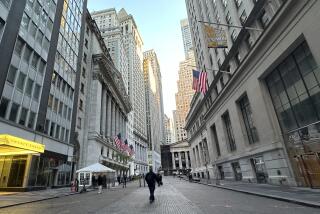Gains in Home Sales, Key Indicator Hint at Recovery : Recession: January figures add to signs that the economy may soon turn around. But many economists recall false forecasts of last spring.
- Share via
WASHINGTON — Providing fresh signals that a recovery may finally be in the works, the government reported Tuesday that its main barometer of future economic activity posted its biggest increase in six months, while sales of new homes surged to the highest level in a year in January.
The latest figures come on the heels of other recent signs that the dramatic interest rate slashes by the Federal Reserve Board late last year are beginning to stimulate the housing industry. And a ripple effect appears to be gradually influencing other sectors of the economy.
The Commerce Department said that the index of leading economic indicators rose 0.9% in January, adding that the declines posted in the index in November and December were not as steep as previously reported. The leading indicators are designed to help forecast economic activity several months in advance.
Meanwhile, the Commerce Department and Department of Housing and Urban Development also said that new home sales rose a surprising 12.9% in January, thanks largely to an enormous 63% gain in the Midwest.
Federal Reserve Chairman Alan Greenspan once again responded cautiously to the data, telling Congress on Tuesday that he sees “a few hopeful signs” that the recession is ending. He added that he believes the actions already taken by the Fed to cut interest rates should be enough to pull the economy into a recovery but said that the Fed may cut rates again if the recovery does not spread throughout the economy soon.
Meanwhile, President Bush, whose handling of the economy has become the No. 1 issue in his reelection campaign, also said that he is pleased by the figures. But he conceded that it is still too early to declare that the longest recession since World War II has ended.
“I don’t want to put too much on it,” Bush said, “but I was very pleased . . . and so it is nice to have some encouraging news.”
Greenspan and other economists remain wary that the economy may stall just as last spring’s fledgling recovery was choked off. In fact, some economists believe that some regions, including Southern California, may show signs of further decline over coming months as the Pentagon spending cuts accelerate.
Even Michael J. Boskin, chief White House economist, added a cautious note. “There are some tentative signs of improvement in some sectors,” he said in an interview, “but I’d like to see these spread more broadly and for a longer period.”
But if these early signs of a recovery are followed soon by more consistent signs of economic growth, that may reduce the pressure on the Federal Reserve to cut interest rates and on President Bush and Congress to pass an anti-recessionary tax-cut package. Friday’s report on the February unemployment rate, for example, may be crucial in determining whether the Fed believes that it should cut rates further. A decline in the unemployment rate would provide the most convincing evidence to date that the economy has begun to turn around.
“We are starting to see beginnings of a turn, but it’s not here yet,” said David Wyss, an economist at DRI-McGraw Hill, an economic forecasting firm in Lexington, Mass.
If the economy does turn up, it seems increasingly clear that housing will be the engine that will pull it out of the slump. Tuesday’s report on new home sales follows an earlier one which said that housing construction starts during January rose 5.5%. Lower interest rates have also allowed many current owners to refinance their mortgages at lower rates, potentially giving them greater disposable income.
Some economists believe that cheaper mortgage payments helped spur a slight, 0.6% rise in retail sales in January, although some retail analysts believe that much of that increase was the result of steep, post-Christmas discounting by department stores.
One troubling trend is the recent rise in long-term interest rates, which many economists now worry may dampen the economy’s ability to recover. Rates on mortgages and other long-term investments have started to rise as financial markets increasingly appear to sense that a recovery is near, and as traders become concerned that the White House and Congress may pass a highly stimulative tax-cut proposal that would increase the federal deficit.
Fixed, 30-year mortgage rates are now well above their low levels in December after the Fed’s last interest-rate reductions. Rising long-term rates will make it more difficult for homeowners to refinance their mortgages at cheaper rates, while also making homes less affordable for first-time buyers.
That rise in long-term rates is beginning to trouble the White House and is leading some senior Administration officials to debate just how hard to press for a tax-cut package this year. President Bush already has vowed to veto the likely Democratic tax proposal, which is expected to include an income tax increase on the wealthy to pay for middle-class tax relief.
Senior Administration officials say that they may decide not to try to renew the tax debate after the President’s veto, both for political and economic reasons.
Such a decision would certainly help the President politically with conservatives by allowing him to say he had stopped a Democratic tax increase, but ending the debate quickly would also reduce the uncertainty surrounding tax policy that is now putting pressure on the financial markets to raise long-term interest rates.
More to Read
Inside the business of entertainment
The Wide Shot brings you news, analysis and insights on everything from streaming wars to production — and what it all means for the future.
You may occasionally receive promotional content from the Los Angeles Times.










